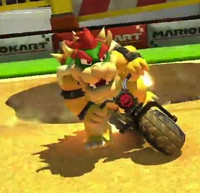

An additional, and very happy sounding saxophone solo completes the loop, and breathes a fresh air into the melody. The trumpets come in explosively at the end of each measure, complementing the synthetic electronic melody, which is played up to represent Mario Kart 8’s main feature: anti-gravity races. This melody is repeated in Shiho Fuji’s arrangement of “Mario Circuit,” featuring a more relaxed style, and an almost retro-sounding bass riff. Arranged by Yasuaki Iwata, who employs an active brass section, backed up by bass and electric guitars and drums, the piece moves smoothly from one statement of its melody to another, which is occasionally delegated to MIDI strings. The soundtrack’s first disc starts out with what can actually be identified as the main theme of 8, “Mario Kart Stadium,” a triumphant piece that excitedly foretells the way some of the courses’ music plays out generally. It’s a great jazz piece in itself though on the release it actually plays during the soundtrack’s last fourth on the second disc, a rather odd choice if you ask me. The first time I heard the theme, I actually got overjoyed to start playing, and that’s before the song transitions into its second half, a big band arrangement of Super Mario Kart’s main theme, which has been re-arranged since Mario Kart 64, but hasn’t returned to its original chord progression until now. This can be best encapsulated with 8’s title screen theme, “Mario Kart 8,” composed by Atsuko Asahi and featuring some brilliant interplay between electric guitars, high-energy trumpets and saxes, and a bassy rhythm that evokes the overall feel of Mario Kart.
MARIO KART 8 EXCITEBIKE MUSIC SERIES
It should be noted that Mario Kart 8 is the first in the series to not include any repeated track songs, and also includes new arrangements of classic songs and main themes in the series, making this the most complete soundtrack release for Mario Kart as a whole.

The second disc on the other hand covers the DLC courses, and later switches gears to the menu themes and incidental music of the game. The soundtrack set is neatly split in half, with the first disc being solely dedicated to the original and retro courses originally included on the game’s release. Thankfully Nintendo has at least released 8’s music on a limited 2 disk soundtrack set, available exclusively to Club Nintendo of Japan and Europe members. In-game, everything is perfectly synced to the speed, rhythm and settings of the race, making this soundtrack one of Nintendo’s most lively and kinetic.

Like Super Mario 3D World, Mario Kart 8 features live instrumental performances mostly done in a big-band jazz sound, which features Nintendo composers and arrangers Yasuaki Iwata, Shiho Fujii, Atsuko Asahi, Ryo Nagamatsu, Satomi Terui, Asuka Ohta, and Kenta Nagata, alongside over 20 live performers. However, something that captivated fans, including myself, right from the get-go with 8 was its music and sound design. That may seem like an odd statement, considering that the Mario Kart spinoff games are a tent-pole franchise for Nintendo, and yet Mario Kart 8 is the Wii U’s bestselling game, blooming with a gorgeous art-style, some spectacular effects, and, most importantly, an overabundance of creative fun, making this kart-racer the most exciting entry in the series. Mario Kart 8 can best be described as an unexpected surprise.


 0 kommentar(er)
0 kommentar(er)
